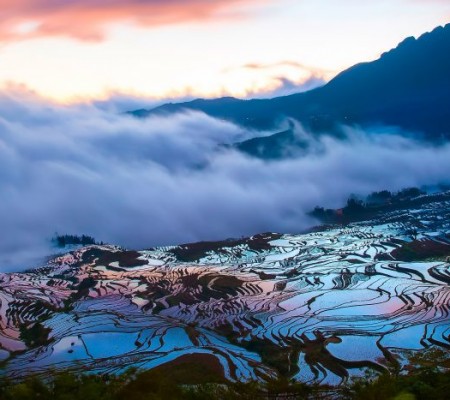
Zhengdong Town of Jiangcheng County in Puer City
Chinese Name: 整董镇
English Name: Zhengdong Town of Jiangcheng County in Puer City
Zhengdong Town (整董镇), located in the southwest of Jiangcheng Hani and Yi Autonomous County (江城哈尼族彝族自治县), Puer City (普洱市), is positioned near the Laos border (老挝) and offers a rich cultural heritage with stunning landscapes. It borders Laos to the southeast, and connects to Mengla County (勐腊县) and Jinghong City (景洪市) to the southwest, while Simao District (思茅区) lies to the northwest across the river.
With an area of 305 square kilometers, Zhengdong Town is home to over 10,000 residents and is known for its Dai ethnic community (傣族), who maintain their distinctive culture and language. The town has developed significantly in recent years and is an ideal place for tourists seeking cultural experiences and natural beauty.
Geography and Administrative Division
Zhengdong Town is located in the southwestern part of Jiangcheng County, with neighboring Laos to the southeast and Mengla County (勐腊县) to the southwest. The town is about 59 kilometers from Jiangcheng County and has well-connected roads to Simao District (思茅区). As of 2020, the town includes three administrative villages: Zhengdong Village (整董村), Mantan Village (曼滩村), and Huashiban Village (滑石板村), with the town government located in Zhengdong Village.
Cultural Features and Local Customs
Dai Ethnic Group
The town is predominantly inhabited by the Dai people (傣族), who are well-known for their traditional stilt houses (干栏式建筑), a characteristic of their architecture. The community has preserved its Dai language (傣族语言) and cultural practices, which include vibrant festivals such as the Water Splashing Festival (泼水节), an important event in Dai culture.
Architecture and Festivals
The traditional Dai-style stilt houses remain an iconic feature of the town, showcasing the region’s ethnic diversity and historical significance. These houses are designed to withstand the tropical climate, with a raised platform that helps keep them cool. Traditional festivals such as the Water Splashing Festival offer an exciting opportunity to experience the region’s cultural vibrancy.
Tourist Attractions and Unique Experiences
Key Attractions
-
Mantan Dai Village: This well-preserved traditional Dai village offers an authentic experience of Dai culture and architecture.
-
Re Shui River Hot Springs: A natural hot spring offering a relaxing and rejuvenating experience with a pristine environment.
-
Border Views: The natural beauty of the Nalan River (南腊河) and other nearby rivers provides a scenic backdrop, with panoramic views of Laos across the border.
Unique Experiences
-
Dai Guesthouse Stays: Stay in traditional Dai homes and experience the simple yet charming lifestyle of the village.
-
Local Cuisine: Savor traditional Dai dishes, such as sticky rice (糯米饭), brown sugar sticky rice cakes (红糖糯米粑粑), and other local delicacies.
-
Cultural Festivals: Join in the lively celebrations during the Water Splashing Festival and other ethnic events.
Practical Travel Information
Best Time to Visit
The best time to visit is from November to April during the dry season when the weather is pleasant. The Water Splashing Festival in April is an excellent opportunity to experience Dai culture and traditions at their most vibrant.
How to Get There
-
By Car: Zhengdong Town is approximately 1 hour’s drive from Jiangcheng County (江城县), with well-maintained roads.
-
Public Transportation: You can take a bus to Zhengdong Town and then transfer to local transport to reach the town center.
Food and Accommodation
-
Local Cuisine: Enjoy Dai BBQ (傣味烧烤), bamboo rice (竹筒饭), and sour bamboo fish (酸笋煮鱼), which are staples of the local cuisine.
-
Accommodation:
-
Dai Guesthouses (傣家乐民宿), with rates ranging from 100-200 RMB per night.
-
Zhengdong Town Hotels (整董镇酒店), offering more complete facilities.
-
Historical Evolution
Zhengdong Town has a long history, dating back to 1908 during the Qing Dynasty (清朝), when it was governed by the Dai chieftains. The region’s administrative structure has undergone several changes, with the area becoming part of Jiangcheng County (江城县) in the 1950s and later transitioning into a town in 1988.
Geography and Natural Features
Terrain and Climate
Zhengdong Town lies in an irregular rectangular shape, running north-south and narrow from east to west. The highest point is Beiyin Mountain (背阴山), with an elevation of 1,698 meters, while the lowest point is Jiangbian Village (江边寨) at 820 meters above sea level. The town enjoys a subtropical monsoon climate, with an average annual temperature of 19.6°C. It experiences abundant rainfall and generally warm weather year-round.
Water Systems
The region is part of the Lancang River (澜沧江) basin, with several rivers flowing through the area, including Manlao River (曼老江), Buliao River (布老河), Xiangzhuang River (象庄河), and Mantan River (曼滩河), all contributing to the natural beauty of the town.
Local Economy and Infrastructure
Economic Development
The economy of Zhengdong Town primarily relies on agriculture, with local production of rice (水稻), rubber (橡胶), and other crops. Over the years, the village has seen steady progress in improving its infrastructure and tourism offerings, increasing the number of local businesses, and enhancing the livelihoods of its residents.
Transportation and Communication
Zhengdong Town has a county-level highway (县乡级公路) connecting it to surrounding areas. The town also has a bus station with regular services to Jiangcheng County and beyond.
Cultural Significance
Name Origin
The name Zhengdong comes from the Dai language, where “Zhengdong” (整董) originally meant “Copper City”, symbolizing the area’s historical significance.
Zhengdong Town offers a rare glimpse into the life and culture of the Dai ethnic group. With its unique architecture, colorful festivals, and rich history, it’s a perfect destination for travelers seeking an authentic cultural experience in Yunnan Province (云南省).

 7 Days GolfingTour
7 Days GolfingTour
 8 Days Group Tour
8 Days Group Tour
 8 Days Yunnan Tour
8 Days Yunnan Tour
 7 Days Shangri La Hiking
7 Days Shangri La Hiking
 11 Days Yunnan Tour
11 Days Yunnan Tour
 6 Days Yuanyang Terraces
6 Days Yuanyang Terraces
 11 Days Yunnan Tour
11 Days Yunnan Tour
 8 Days South Yunnan
8 Days South Yunnan
 7 Days Tea Tour
7 Days Tea Tour
 8 Days Muslim Tour
8 Days Muslim Tour
 12 Days Self-Driving
12 Days Self-Driving
 4 Days Haba Climbing
4 Days Haba Climbing
 Tiger Leaping Gorge
Tiger Leaping Gorge
 Stone Forest
Stone Forest
 Yunnan-Tibet
Yunnan-Tibet
 Hani Rice Terraces
Hani Rice Terraces
 Kunming
Kunming
 Lijiang
Lijiang
 Shangri-la
Shangri-la
 Dali
Dali
 XishuangBanna
XishuangBanna
 Honghe
Honghe
 Kunming
Kunming
 Lijiang
Lijiang
 Shangri-la
Shangri-la
 Yuanyang Rice Terraces
Yuanyang Rice Terraces
 Nujiang
Nujiang
 XishuangBanna
XishuangBanna
 Spring City Golf
Spring City Golf
 Snow Mountain Golf
Snow Mountain Golf
 Stone Mountain Golf
Stone Mountain Golf














